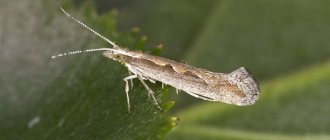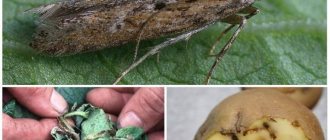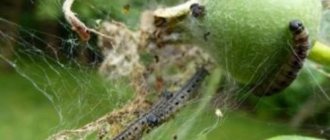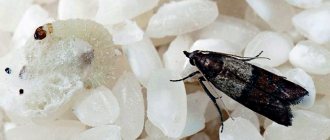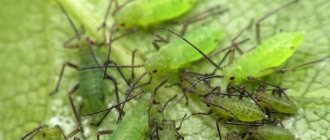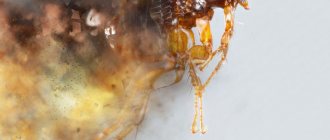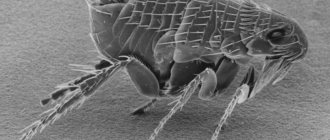Fruit moth
Moth in fruit
Methods for killing moths
Fruit moth is a type of food moth. The insect lives for about a month, and stays in the form of a butterfly from 3 to 14 days. The pests are carried out by moth larvae - voracious caterpillars that eat any food supply, not just fruit. In nature they are found on fruit trees, hence the name. Active in the warm season.
Appearance
The fruit moth goes through several stages of development. In everyday life, a moth is usually called a nondescript moth of a gray, brownish color. The size does not exceed 3 cm with open wings. Butterflies are active in the dark, but you can periodically notice moths fluttering during the day.
On a note!
Moth eggs are extremely small and almost impossible to notice with the naked eye. One female lays up to 100 pieces during the entire life cycle - 3-14 days under favorable conditions.
The larvae are white caterpillars or worms with a dark “muzzle”. The food inside is visible through the translucent covering of the body.
The moth larval phase ends with the formation of a cocoon, pupation. After 2-3 days, a moth appears. There are no significant differences in the appearance of females and males. The fruit moth is pictured below.
Fruit moth
How to store your own dried fruits
Experienced housewives, who have never thrown away spoiled fruits, try to prepare them on their own and preserve them for a long time. To ensure that they are stored properly and for a long time, we recommend taking certain measures.
Store different fruits and nuts in separate containers
Drying rules and preparation for storage:
- To ensure that fruits dry evenly, you need to cut them into equal pieces or slices.
- During the drying process, the finished dried fruits are put in a cooler place, the remaining chopped fruits are turned over and tossed, bringing them to the required drying.
- Select storage containers that are hermetically sealed: dense but breathable bags, containers with lids or glass jars.
- Before packaging, the containers must be sterilized; containers, if they are not heat-resistant, are disposable.
- Fill them with dried fruits to 2/3 of the height, leaving room for air.
- Containers are stored at a temperature of about +10 degrees.
During the entire storage period, it is necessary to check the condition of the product, taking into account humidity and the presence of pests. The main insects that attack dried fruit are fruit moths and aphids.
Ways to enter the house
An insect enters a person’s home in several ways. Sometimes the owner or housewife brings the pests themselves, but they notice the presence of living creatures in the house after about 2 weeks.
You can list several ways where moths come from in an apartment. How an insect gets into the house:
- Through open windows. The butterfly is active in the dark and is attracted by the light of evening windows and lanterns. It flies into a room, finds a suitable place to lay eggs, and dies a few days later. In most cases, one moth goes unnoticed; the owners learn about the infestation of the apartment after the appearance of voracious larvae.
- In the warm season, pest eggs may end up on apples and pears that people use for drying. Over time, dried fruits are placed in a dark place - a cabinet, closet, pantry, cardboard box, and this is a favorable place for the development of larvae.
- Fruit moths are brought into the house with food from the store. Moths do not always live in dried fruits. In the absence of these products, the moth lays eggs in cereals, flour, tea, and nuts. The moth actively feeds on these products. Only coffee and spices are not attractive. Even in closed containers or sealed bags there may be eggs, larvae and butterflies.
Important!
The life cycle of the fruit moth does not exceed 30 days, of which the eggs develop for three days, the butterfly flutters for only 14 days, the rest of the time is spent parasitizing the larvae, which pose great harm to humans.
Moth in fruit
Fighting methods
There are several ways to get rid of moths in dried fruits and other contaminated products. The main control methods are aimed at destroying the larvae, but butterflies should not be left without attention.
If there is a moth in dried fruit, its presence can be detected by the presence of white caterpillars of different sizes, grains from the chewed mass, and cobwebs. At the same time, small moths may periodically flutter around the kitchen. How to get rid of moths in dried fruit depends on the degree of infestation.
- Sort through the dried fruits, place on a baking sheet, and roast in the oven for a few minutes. In this way, eggs are destroyed, larvae, and butterflies are removed manually.
- After a thorough inspection, sort out the dried fruits and place them in places with bright sunlight. In this way, unfavorable conditions are created for the development of fruit pest larvae.
- In case of severe infection, it is easier to throw the dried fruits along with the container outside into the trash can. If food was stored in a cloth bag, it can be washed in hot water to destroy pest eggs.
Destruction of moths
Methods of killing moths
The moth is not distinguished by its quick reaction or strong flight abilities. It's easy to slam him. But there is no guarantee that this is the only or last butterfly in the room, so you should play it safe and use effective moth repellents in the apartment and in the kitchen in particular.
- Sticky tapes are hung around the kitchen, anti-moth tablets and special traps are used in cabinets.
- Among the folk remedies, herbs such as lavender, peppermint, chamomile, and geranium will help repel the pest. These plants repel moths with their scent. Orange peels and garlic are also excellent repellents.
- Ventilating the kitchen for 20 minutes every evening during cold periods reduces the activity of moths and creates unfavorable living conditions for them.
- In case of severe infestation of the premises, aerosols and moth sprays are used. Initially, they carry out cleaning to destroy the larvae, wipe down the cabinets, and hide the food in airtight containers. Disinsection is carried out. Use any insecticidal agent - Raptor, Raid, Antimol, Clean House, Dichlorvos. After 20 minutes, ventilate, carry out wet cleaning by adding baking soda and laundry soap to the water. An alkaline environment completely neutralizes the effect of the insecticide.
How to get rid
If the moth is already flying around the kitchen with all its might, and food is filled with its larvae, then urgent measures must be taken. There are various ways to get rid of fruit moths. The main thing is to act without delay.
As soon as larvae are noticed, the following measures must be taken immediately::
- All contaminated products must be disposed of without regret, since such dried fruits are no longer suitable for consumption and can even be dangerous.
- All drying storage containers must be treated with a vinegar solution.
- Shelves and cabinet walls with contaminated dried fruits are also treated with vinegar. This is necessary in order to get rid of eggs and larvae that may have ended up in crevices and hard-to-reach places.
When treating surfaces with vinegar solution, the housewife should protect her hands with rubber gloves from chemical burns. It is advisable to leave the vinegar solution on the surface for 30 minutes. This will completely destroy the pests.
But since vinegar has a strong unpleasant odor, the cabinets need to be thoroughly ventilated after treatment.
Video
How to get rid of moths quickly and forever
Traditional methods
An experienced housewife has various folk methods in her arsenal on how to get rid of fruit moths in the kitchen. However, when fighting insects using traditional methods, it is important to remember that the pest gradually develops immunity to them. Therefore, they should be changed periodically in order to improve the results and preservation of dried fruits.
Getting rid of kitchen moths in the kitchen can be achieved with the following means::
- Lavender. This plant has a strong aroma that almost all insects cannot tolerate. You can sew fabric bags, fill them with dried lavender and place them in a drying cupboard. Or you can use dried mint or lemon balm.
- Bay leaf. Several leaves can be placed in habitats for winged insects. They will also repel pests, but experienced housewives note that laurel is less effective than lavender.
- Citrus. The zest of orange, tangerine, and grapefruit emits a strong aroma that repels pests. But the essential oils from them quickly evaporate, so the crusts need to be replaced with new ones from time to time.
But using folk methods to get rid of moths is rarely possible. They are more suitable for preventing the appearance of fruit butterflies.
Preventive methods
Methods that can be used to protect food from flying insects may include the following::
- Sticky tapes are hung around the kitchen. On the shelves of the cabinets there are traps and tablets suitable for the food area.
- With the arrival of cold weather, it is useful to leave the kitchen window open for 20 minutes every evening. Low temperatures have an adverse effect on moths and reduce their activity.
- In case of severe infestation of the premises, after the appearance of a large number of moths, insecticides can be applied. But before using them, all food supplies must be placed in airtight containers. Disinsection is carried out, and after 20 minutes the cabinets are ventilated. They are also additionally wiped with baking soda or laundry soap to eliminate the strong smell of insecticides.
An adult moth is easy to swat because it does not react quickly. However, this will not guarantee that the premises are free of pests.
Prevention methods
Preserving dried fruits from moths at home is quite difficult, but if you wish, you can avoid troubles.
- Store dried fruits in places with bright sunlight or in a room with low temperatures.
- Periodically sort through the supplies and heat in the oven for a few minutes.
- Wipe cabinets with water and vinegar or place repellents. The moth is afraid of a pungent odor, but with constant presence it gets used to it, so protection should be alternated.
- Place special traps, tablets, cassettes against moths and their larvae next to dried fruits.
You need to begin active actions immediately after discovering at least one moth or caterpillar. Knowing what moths are afraid of, you can quickly eliminate the problem. Otherwise, all food supplies will be contaminated, which will then have to be thrown away. Due attention should be paid to proper storage of dried fruits.
Preventing moths in the kitchen
Mostly moths appear where there is poor ventilation, high humidity, and they also love warmth. In order to avoid its appearance in the kitchen, you should adhere to basic rules:
- Store the entire range of cereals, dried fruits, nuts tightly closed (use jars: glass, tin, plastic) or well-closed plastic bags;
- Try not to store them for a long time in the kitchen, where this insect can appear, but constantly use them, and also conduct an audit of existing supplies;
- After purchasing cereals, fry them;
- Keep all cabinets and shelves where food is stored clean, wipe them with vinegar, and ventilate them frequently.


